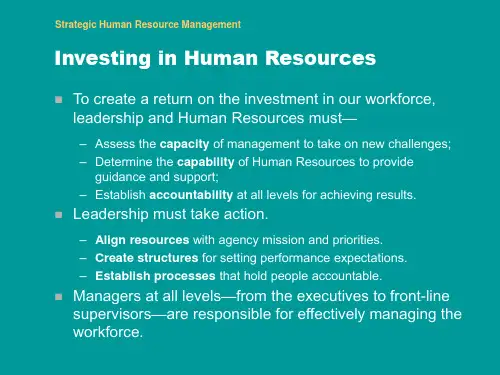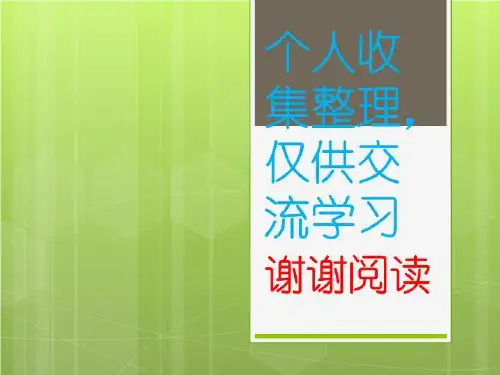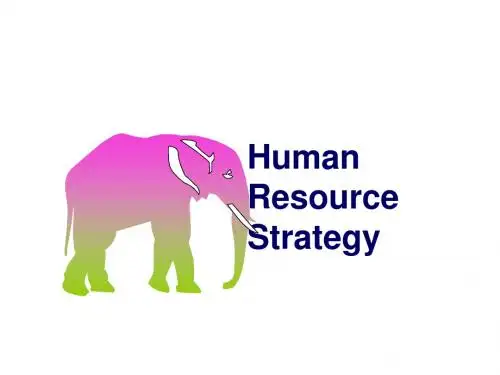战略人力资源管理培训讲义(英文版)
- 格式:ppt
- 大小:145.00 KB
- 文档页数:20
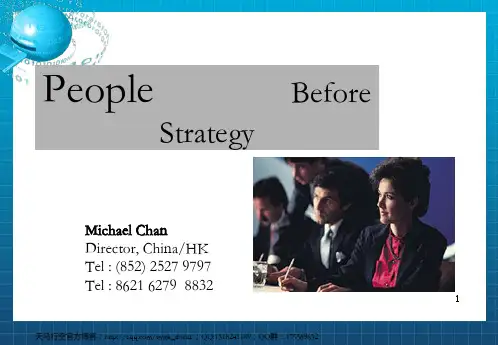

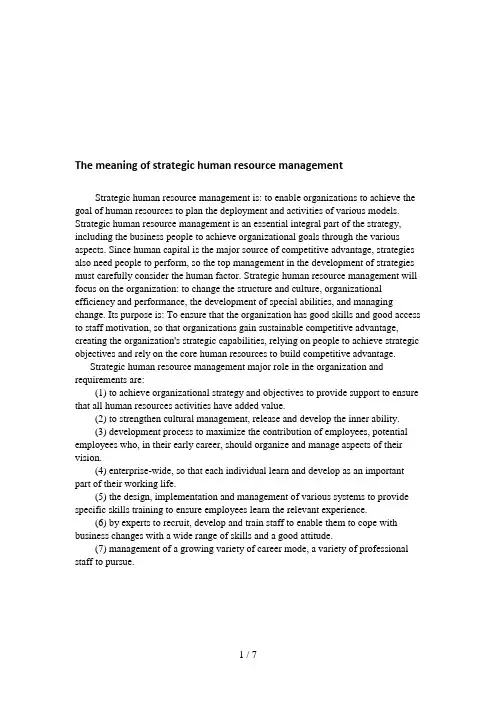
The meaning of strategic human resource managementStrategic human resource management is: to enable organizations to achieve the goal of human resources to plan the deployment and activities of various models. Strategic human resource management is an essential integral part of the strategy, including the business people to achieve organizational goals through the various aspects. Since human capital is the major source of competitive advantage, strategies also need people to perform, so the top management in the development of strategies must carefully consider the human factor. Strategic human resource management will focus on the organization: to change the structure and culture, organizational efficiency and performance, the development of special abilities, and managing change. Its purpose is: To ensure that the organization has good skills and good access to staff motivation, so that organizations gain sustainable competitive advantage, creating the organization's strategic capabilities, relying on people to achieve strategic objectives and rely on the core human resources to build competitive advantage.Strategic human resource management major role in the organization and requirements are:(1) to achieve organizational strategy and objectives to provide support to ensure that all human resources activities have added value.(2) to strengthen cultural management, release and develop the inner ability.(3) development process to maximize the contribution of employees, potential employees who, in their early career, should organize and manage aspects of their vision.(4) enterprise-wide, so that each individual learn and develop as an important part of their working life.(5) the design, implementation and management of various systems to provide specific skills training to ensure employees learn the relevant experience.(6) by experts to recruit, develop and train staff to enable them to cope with business changes with a wide range of skills and a good attitude.(7) management of a growing variety of career mode, a variety of professional staff to pursue.Strategic human resource management theory(1) Value. Strategic human resource management and general human resources management major difference is that it emphasizes human resource management activities closely with the corporate strategy, its functions include acquisition, development, evaluation and incentives directly into the corporate strategic planning and implementation process. Human resources management is to a strategic level, which in itself is for human resource managers a powerful incentive to encourage them to change the thinking, broaden their horizons, from the overall situation, the effective integration of human resource management system and make the efficient functioning of the human resource management will become a source of value creation.(2) scarcity. Human resource management of each organization are rooted in corporate organizational culture and a certain social norms, and by the internal and external environment of enterprises made a comprehensive analysis of strategies to guide, that in itself is unique, proprietary organizations, which is also scarce.(3) the difficulty of imitation. Strategic human resource management to emphasize that human resources management system integration and corporate strategy, stage of development of each organization and the resources on their own ability to create competitive advantage are different, in addition, the establishment of human resource management based on past experience on itself is an evolving process of evolution and re-accumulation, showing that inter-organizational human resources management system is a great difference. Strategic human resource management focuses on human resource management and enterprise strategy, while the longitudinal match practice to achieve its lateral match between the organization's internal and external environment in which the uncertainty in turn determines the match should be a dynamic, flexible. This dynamic matching tissue embedded in a particular environment, because of its unique and difficult to be imitated by competitors.(4) is not irreplaceable. Strategic human resource management emphasis on human resource management and the formation of corporate strategy integration, from a strategic height deployment of human resources. Human resources become the first resource in the organization, material resources, the role of human resources should be adopted, its value can be the ultimate expression. Therefore, when the major decisions in the face of business, capital, technology and other production factors to consider, but the issue of human resources compared to the significantimpact organizational decision making, they are replaced in human resources can not be realized.Strategic human resource management on the impact of management activitiesStrategic human resource management, human resources, it is concerned about the systematic, integrated, and the direction of the new, the theme of the new policy, rather than trivial details and specific technique, which makes human resource management from a relatively "low" transactional work out of them, located in the core business with the organization closer to the theme, so they have more important strategic position and role. Therefore, the strategic human resource management is not only a new management model, but should be an advanced management ideas and concepts. No doubt this idea and concept of the current human resources management will have a profound impact.(1) shift in the focus of work and the work function of the expansion. Human resource management focus will be located in those organizations is more important long-term sustainable development of the subject, it is no longer confined to the core of the labor organization to obtain and develop their motivation, in order to evaluate its performance, and as to the Pay basis, but the strategic decision-making in the organization play a more proactive role, specifically including the transformation of organizational structure, reconstruction process of optimizing the operation of the organization, fostering organizational culture building, change the organization's leadership style, adjusting the organizational communication Organization's work to create atmosphere, staff attitude research organizations to improve the organization's employee job satisfaction, and strengthen the development of effective means for the organization, both organizations and employees win the value of the common growth of other aspects. At this point, human resource managers assume a strategic partner, management experts, staff motivator and role of change agents 4.(2) human resources management to improve organizational performance in the fundamental role to play. Strategic human resource management that human resources are the organization achieve its goals, the most important resource for sustainable development, namely, human resources are the key considerations in organizational decision-making; have access to human resources, development, evaluation and incentives should match the strategic objectives of the organization it becomes a vital part of management. The organization's human resources management as the most direct and important practitioners of human resource management activities, will become the core of the organization and management department. Human resources departments will strengthen its own building, will be more focus on the improvement of organizational performance and organizational performance in particular play a decisive role in the key performance, thereby improving the performance of its human resources operation in the effective corporate strategy , and promoting the organization to complete the strategic plan.战略性人力(rénlì)资源管理的内涵战略性人力(rénlì)资源管理是指:为了(wèi le)使组织能够达到目标,对人力(rénlì)资源各种部署和活动进行计划的模式。


人力资源战略性管理概述(英文版)An Overview of Strategic Human Resource Management IntroductionStrategic human resource management (SHRM) is a proactive approach that aligns the human resource practices with the overall strategic goals and objectives of an organization. It focuses on managing employees as valuable assets and leveraging their skills and competencies to gain a competitive advantage in the market. This article provides an overview of strategic human resource management and its importance in modern organizations.Key Concepts of SHRM1. Alignment with Business Strategy: SHRM ensures that the human resource practices are aligned with the overall business strategy of the organization. This alignment helps in maximizing the contribution of employees towards achieving organizational goals.2. Integration with Organizational Systems: SHRM integrates human resource practices with other functional systems in the organization such as finance, marketing, and operations. This integration ensures that human resource decisions are consistent with the overall organizational objectives.3. Performance-based Approach: SHRM emphasizes on measuring and evaluating the performance of employees and linking it to the rewards and recognition systems. This approach motivatesemployees to perform at their best and contributes to organizational success.4. Talent Acquisition and Retention: SHRM focuses on attracting and retaining talented individuals who can contribute significantly to the organization's success. It involves effective recruitment, selection, and retention strategies to ensure a high-performing workforce.5. Training and Development: SHRM emphasizes on continuous learning and development of employees to enhance their skills and abilities. It involves providing training opportunities, mentoring, and coaching programs to enhance employee performance.Benefits of SHRM1. Improved Organizational Performance: SHRM helps in improving overall organizational performance by aligning human resource practices with strategic goals. It ensures that employees have the necessary skills and competencies to contribute towards achieving business objectives.2. Competitive Advantage: SHRM enables organizations to gain a competitive advantage by leveraging their human capital effectively. It helps in attracting and retaining talented employees and creates a high-performance work culture.3. Increased Employee Engagement: SHRM focuses on creating an engaging work environment where employees feel valued and motivated. This leads to increased job satisfaction, lower turnoverrates, and higher productivity levels.4. Better Decision Making: SHRM involves a data-driven approach to HR decision making. It involves collecting and analyzing HR metrics to make informed decisions about talent management, workforce planning, and performance management.Challenges of SHRMImplementing SHRM can pose several challenges for organizations:1. Resistance to Change: Implementing strategic HR practices requires a shift in mindset and culture within the organization. Resistance to change from employees and managers can hinder the successful implementation of SHRM.2. Lack of HR Expertise: Organizations may lack the necessary HR expertise and resources to implement strategic HR practices effectively. This can hinder the successful execution of SHRM initiatives.3. Integration with Organizational Strategy: Aligning HR practices with the overall business strategy requires collaboration and coordination between HR and other functional departments. Lack of integration can lead to inconsistencies in decision making. ConclusionStrategic human resource management is essential fororganizations to achieve their strategic goals and gain a competitive advantage. It focuses on aligning HR practices with business strategy, integrating HR with other functional systems, and emphasizing a performance-based approach. Implementing SHRM can lead to improved organizational performance, increased employee engagement, and better decision-making. However, organizations may face challenges such as resistance to change and lack of HR expertise during the implementation process. Overall, SHRM plays a crucial role in effectively managing human capital and driving organizational success.I. Strategic HR PlanningOne of the key aspects of strategic human resource management is strategic HR planning. This involves forecasting the organization's future HR needs and developing strategies to meet those needs. Strategic HR planning involves the following steps:1. Environmental Scan: Organizations need to analyze their internal and external environments to identify factors that can impact their HR needs. This can include analyzing the labor market, technological advancements, changing demographics, and industry trends.2. Forecasting HR Needs: Based on the environmental scan, organizations can forecast their future HR needs. This involves estimating the number of employees required, the skills and competencies needed, and the timing of these requirements.3. Gap Analysis: Once the future HR needs are forecasted, organizations can compare them with their current HR capabilities. This helps identify any gaps or areas where additional resources,skills, or competencies are required.4. HR Strategies: Based on the gap analysis, organizations can develop HR strategies to bridge the gaps and meet the future HR needs. This can involve recruiting and hiring new employees, training and developing existing employees, outsourcing certain functions, or implementing flexible work arrangements.II. Talent Acquisition and RetentionAnother important aspect of strategic HR management is talent acquisition and retention. With increasing competition for talent, organizations need to develop effective strategies to attract and retain the right employees. Here are some key components of talent acquisition and retention:1. Employer Branding: Organizations need to establish a strong employer brand to attract top talent. This involves creating a positive reputation as an employer and highlighting the organization's values, culture, and benefits.2. Recruitment and Selection: Strategic HR management focuses on attracting and selecting the right individuals who align with the organization's strategic goals. This can involve targeted recruitment efforts, using multiple sourcing channels, and implementing rigorous selection processes.3. Employee Value Proposition: Organizations need to offer a compelling employee value proposition to attract and retain talented individuals. This involves providing competitive compensation and benefits, career development opportunities,work-life balance, and a positive work environment.4. Succession Planning: Strategic HR management involves identifying and developing future leaders within the organization. Succession planning ensures that there is a pool of talent ready to fill key positions when vacancies arise, reducing disruptions to business operations.III. Training and DevelopmentStrategic HR management recognizes the importance of continuous learning and development for employees. Training and development initiatives are designed to enhance employee skills and competencies to meet the organization's strategic goals. Here are some key components of training and development:1. Needs Assessment: Organizations need to identify the training and development needs of their employees. This can be done through performance evaluations, skills assessments, and feedback from managers.2. Training Programs: Strategic HR management involves designing and implementing training programs that address the identified needs. This can include classroom training, on-the-job training, e-learning, mentoring, and coaching programs.3. Talent Management: Training and development initiatives are closely linked to talent management. Organizations need to identify high-potential employees and provide them with targeted development opportunities to prepare them for future roles.4. Evaluation and Feedback: Strategic HR management emphasizes the evaluation and feedback of training and development programs. This helps ensure that the programs are effective and contribute to the organization's strategic goals.IV. Performance ManagementPerformance management is a critical component of strategic HR management. It involves setting clear expectations, measuring employee performance, providing feedback, and rewarding high performers. Here are some key components of performance management:1. Goal Setting: Strategic HR management involves setting clear, specific, and measurable goals for employees. Goals should be aligned with the organization's strategic objectives and should be challenging yet realistic.2. Performance Measurement: Organizations need to develop effective performance measurement systems to evaluate employee performance. This can involve setting key performance indicators (KPIs), using performance rating scales, and conducting regular performance reviews.3. Feedback and Coaching: Strategic HR management emphasizes regular feedback and coaching sessions between managers and employees. This helps identify areas for improvement, provide guidance, and enhance employee performance.4. Rewards and Recognition: Strategic HR management links performance with rewards and recognition systems. Highperformers should be appropriately rewarded and recognized to reinforce a culture of high performance.V. HR AnalyticsStrategic HR management relies on HR analytics to make data-driven decisions. HR analytics involves collecting and analyzing HR metrics to gain insights and drive strategic decision-making. Here are some key components of HR analytics:1. Data Collection: Organizations need to collect relevant HR data such as employee demographics, turnover rates, performance data, training metrics, and recruitment statistics. This data can be collected through HRIS systems, surveys, and other data collection methods.2. Data Analysis: Strategic HR management involves analyzing the collected data to identify patterns, trends, and correlations. This can help spot potential issues and develop targeted strategies to address them.3. Predictive Analytics: HR analytics can be used for predictive modeling, enabling organizations to forecast future trends and make proactive HR decisions. This can include predicting turnover rates, identifying skills gaps, and forecasting future workforce needs.4. Reporting: Strategic HR management emphasizes the reporting of HR analytics to relevant stakeholders. This can include HR dashboards, reports, and presentations to HR leaders, executives, and managers.ConclusionStrategic human resource management is essential for organizations to achieve their strategic goals and gain a competitive edge. It involves aligning HR practices with business strategy, focusing on talent acquisition and retention, emphasizing training and development, implementing performance management systems, and utilizing HR analytics. By adopting strategic HR practices, organizations can effectively manage their human capital and drive organizational success. However, implementing strategic HR practices can pose challenges such as resistance to change and a lack of HR expertise. Overcoming these challenges and leveraging the benefits of strategic HR management can help organizations thrive in today's dynamic business environment.。
